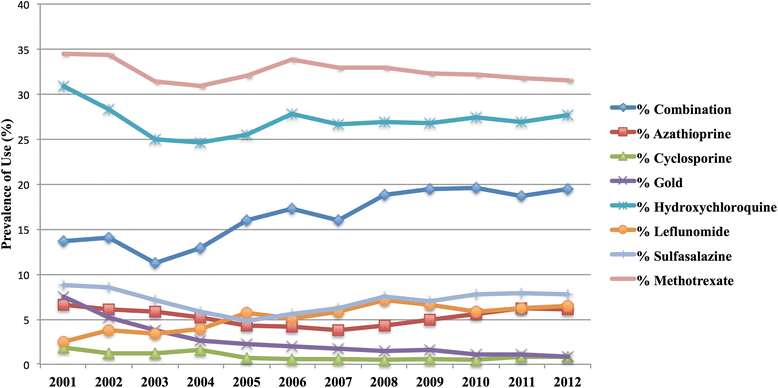Claims for disease-modifying therapy by Alberta non-insured health benefits clients
- PMID: 27557840
- PMCID: PMC4997730
- DOI: 10.1186/s12913-016-1685-y
Claims for disease-modifying therapy by Alberta non-insured health benefits clients
Abstract
Background: Uncontrolled disease activity in inflammatory diseases of the joints, skin and bowel leads to morbidity and disability. Disease-modifying therapies are widely used to suppress this disease activity, but cost-coverage is variable. For Treaty First Nations and Inuit people in Canada without alternative private or public health insurance, cost-coverage for disease-modifying therapy is provided through Non-Insured Health Benefits (NIHB). Our objective was to describe the prevalence and patterns of treatment with disease-modifying therapy for the NIHB claimant population, and also examine adjuvant therapy (analgesics, non-steroidal anti-inflammatory drugs (NSAIDs), corticosteroids) use.
Methods: Cases (n = 2512) were defined by ≥1 claim for a disease-modifying anti-rheumatic drug (DMARD) or biologic between 1999 and 2012 in the NIHB pharmacy claim database. The proportion of the population with claims for individual agents and drug classes annually was calculated to estimate annual incidence and prevalence rates for use of disease-modifying therapy, and the prevalence of use of individual DMARDs, biologics and adjuvants. Differences in the proportion accessing adjuvant therapies and median doses in the 6 months following initiation of disease-modifying therapies was estimated.
Results: The incidence rate of treatment was calculated at an average of 127.5 cases per 100,000 population between 2001 and 2012, and the cumulative prevalence, accounting for patients lost to the database, increased and then stabilized at 1.3 % in the last three years of the study. Annual dispensation of methotrexate, combination DMARD therapy and biologic therapy approached 35 %, 19 %, and 10 % of the cohort respectively. A declining prevalence of claims for acetaminophen (28 % to 15 %) and anti-inflammatories (73 % to 63 %) occurred from 2000 to 2012, however corticosteroid (32 %) and opioid (65 %) dispensation remained stable. The proportion of patients with claims for NSAIDs (69.9 % to 61.1 %, p = 0.002), oral corticosteroids (45.4 % to 33.6 %, p < 0.001) and parenteral corticosteroids (16.2 % to 8.3 %, p = 0.002) decreased in the 6 months following biologic initiation.
Conclusions: The proportion of NIHB clients with active claims for disease-modifying therapy is lower than expected based on existing epidemiologic knowledge of the prevalence of inflammatory conditions in the First Nations and Inuit populations. These findings should be further explored in order to optimize treatment outcomes for NIHB claimants with inflammatory disease.
Keywords: Antirheumatic agents; Arthritis; Immunosuppressive agents; Inflammatory bowel diseases; Pharmacoepidemiology; Psoriasis.
Figures
References
-
- Public Health Agency of Canada . Life with Arthritis in Canada. Ottawa: A Personal and Public Health Challenge; 2010.
MeSH terms
Substances
LinkOut - more resources
Full Text Sources
Other Literature Sources
Medical




